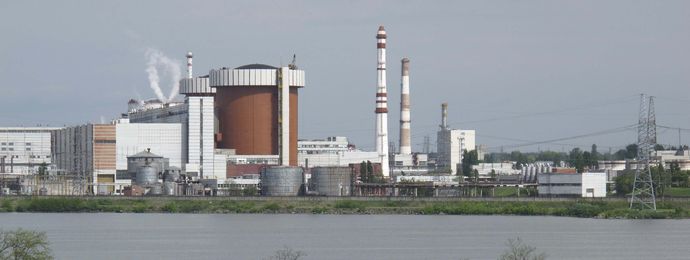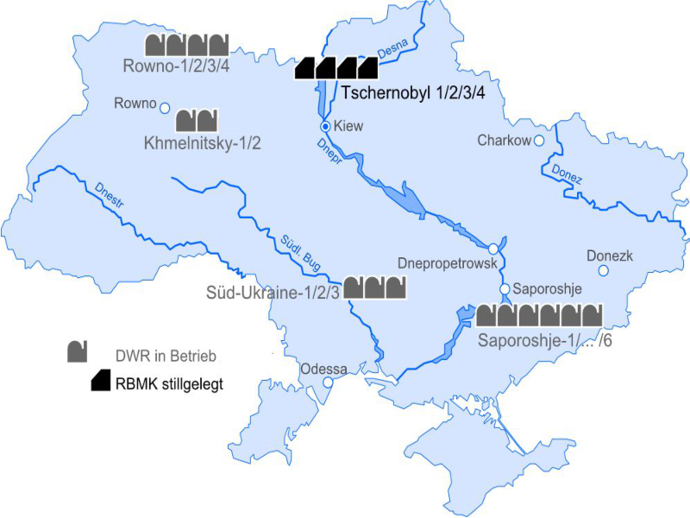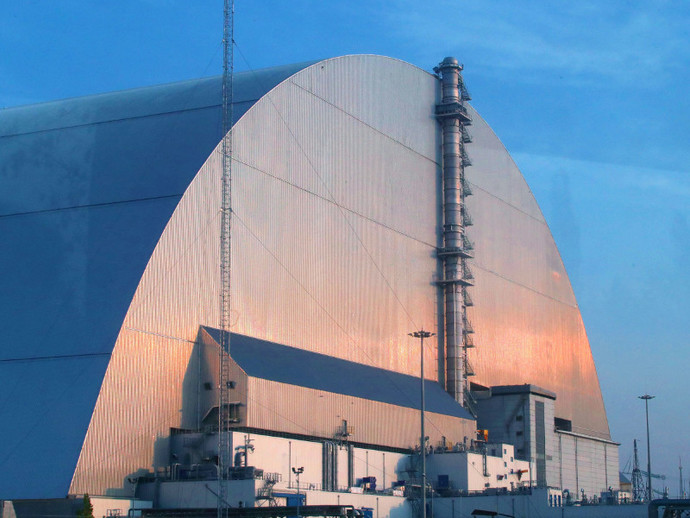-
BASE
subnavigation
BASE
- About us
- Laboratorium
- Career
- Laws and regulations
- Legal Basis
- Manual on Reactor Safety and Radiation Protection
- 1A Nuclear and radiation protection law
- 1B Other laws
- 1C Transport law
- 1D Bilateral agreements
- 1E Multilateral agreements
- 1F EU law
- 2 General administrative provisions
- 3 Announcements of the BMU and the formerly competent BMI
- 4 Relevant provisions and recommendations
- 5 Nuclear Safety Standards Commission (KTA)
- 6 Key committees
- Annex to the NS Handbook
- A 1 English translations of laws and regulations
- Dose coefficients to calculate radiation exposure
- BASE topics in the Bundestag
-
Topics
subnavigation
Topics
Nuclear Safety
Interim Storage / Transport
-
News
subnavigation
Nuclear power plants in Ukraine

![]() Nuclear Power Plant South-Ukraine
Source: picture alliance / REUTERS | GLEB GARANICH
Nuclear Power Plant South-Ukraine
Source: picture alliance / REUTERS | GLEB GARANICH
Ukraine is one of the most nuclear-dependent countries in the world, with nuclear energy accounting for more than 50 percent of electricity production. Currently, four nuclear power plants are in operation in Ukraine:
- Khmelnytskyi
- Rivne
- Zaporizhzhya (Zaporozhye)
- South Ukraine
All reactors in operation are VVER-type pressurised water reactors of Russian design, including those at Europe's largest nuclear power plant in Zaporizhzhya. Two further pressurised water reactors at the Khmelnytskyi site have been under construction since 1986 and 1987 respectively.

![]() Nuclear Power Plant in Ukraine
Source: Gesellschaft für Anlagen- und Reaktorsicherheit (GRS)
Nuclear Power Plant in Ukraine
Source: Gesellschaft für Anlagen- und Reaktorsicherheit (GRS)
Research reactors in Ukraine
In addition to power reactors for commercial electricity generation, Ukraine also has research reactors. These are used to produce neutrons (neutron source) that can be used for various purposes in the fields of technology and medicine. In contrast to commercial nuclear power reactors, research reactors have a significantly lower power output and a lower radiological hazard potential.In the context of the Ukraine war, the research facility in Kharkiv is the main focus of attention.
Research facility in Kharkivshow / hide
Kharkiv is the second largest city in Ukraine and is located in the north-east of the country. An experimental neutron source is about to be commissioned at the Kharkiv Institute of Physics and Technology (KIPT) there. It will be used for scientific experiments and isotope production for medical-biological applications and materials research.
The nuclear material at the facility is subcritical, and the amount of radioactive material is very limited. Major releases of radioactivity can thus be ruled out - even in the event of further damage. However, limited radiological consequences for the population in the region cannot be ruled out.
As early as 24 February 2022, the plant in Kharkiv was transferred into a "deep subcritical state" mode. Since the beginning of March 2022, the research institute has also been subject to shelling by Russian forces and bombing. The institute's buildings and infrastructure were damaged in the process. So far, there are no indications that radioactive substances were released there. The radiological situation is being closely monitored by the Federal Ministry for the Environment (BMUV) and the Federal Office for Radiation Protection (BfS), among others.
Kiev research reactorshow / hide
The WWR-M (Water-cooled Water-moderated Modernised Reactor) research reactor is located at the Nuclear Research Institute of the Academy of Sciences in Kiev. It has been in operation since 1960, and has a thermal output of 10 MW.
The WWR-M has an operating licence from the Ukrainian regulatory authority SNRIU until the end of 2023. The plant is used for research purposes (nuclear and material technology studies) and isotope production for medicine, research and technology.
Research reactors in Sevastopolshow / hide
There are IR-100 SPh IR-100 research reactors and a subcritical assembly using natural uranium as fuel at the Institute of Nuclear Energy and Nuclear Industry in Sevastopol, Crimea.
The IR-100 research reactor has been in operation since 1967. It has a thermal power of 200 kW, and was also used for training purposes. SPh IR-100 is a critical assembly. Due to the low thermal power, critical assemblies do not require cooling. They are particularly suitable for teaching and training purposes.
On 16 June 2014, following Russia's occupation of Crimea, the Ukrainian licensing and supervisory authority SNRIU withdrew the operating licence for the Sevastopol facilities.
Chernobyl
In addition, there are four Soviet-designed RBMK pressure-tube reactors at the Chernobyl site, where the most serious accident in the history of civilian use of nuclear energy happened in April 1986. Three reactor units of the Chernobyl nuclear power plant are now under decommissioning. After the nuclear disaster, the damaged unit 4 was initially covered by a steel and concrete structure. In 2016, a new protective shell, the Safe Confinement structure, was put into place.

![]() Protective shell NSC (New Safe Confinement) made of steel and concrete over reactor block 4
Source: picture alliance / Photoshot
Protective shell NSC (New Safe Confinement) made of steel and concrete over reactor block 4
Source: picture alliance / Photoshot
Data on the Ukrainian nuclear power plants
Nuclear energy plays a major role in Ukraine's electricity supply. The operator of the Ukrainian nuclear power plants is NNEGC Energoatom (National Nuclear Energy Generating Company Energoatom).
| NPP | Installed capacity, MWe, gross | Commission date | Reactor type |
|---|---|---|---|
| Rivne nuclear power plant- | |||
| Unit 1 | 420 | 12/1980 | WWER 440/213 |
| Unit 2 | 415 | 12/1981 | WWER 440/213 |
| Unit 3 | 1.000 | 12/1986 | WWER 1000/320 |
| Unit 4 | 1.000 | 10/2004 | WWER 1000/320 |
| NPP South Ukraine- | |||
| Unit 1 | 1.000 | 12/1982 | WWER 1000/302 |
| Unit 2 | 1.000 | 01/1985 | WWER 1000/338 |
| Unit 3 | 1.000 | 09/1989 | WWER 1000/320 |
| Unit 4 | WWER 1000; construction stopped | ||
| Zaporizhzhya NPP- | |||
| Unit 1 | 1.000 | 12/1984 | WWER 1000/320 |
| Unit 2 | 1.000 | 07/1985 | WWER 1000/320 |
| Unit 3 | 1.000 | 12/1986 | WWER 1000/320 |
| Unit 4 | 1.000 | 12/1987 | WWER 1000/320 |
| Unit 5 | 1.000 | 08/1989 | WWER 1000/320 |
| Unit 6 | 1.000 | 10/1995 | WWER 1000/320 |
| Khmelnytskyi nuclear power plant- | |||
| Unit 1 | 1.000 | 12/1987 | WWER 1000/320 |
| Unit 2 | 1.000 | 08/2004 | WWER 1000/320 |
| Unit 3 | 1.000 | Under construction since 3/1986, completion planned | |
| Unit 4 | 1.000 | Under construction since 2/1987, completion planned | |
| Chernobyl nuclear power plant- | |||
| Unit 1 | 800 | 09/1977 | RBMK-1000 shut down permanently in 11/1996 |
| Unit 2 | 1.000 | 12/1978 | RBMK-1000 not re-commissioned after fire in turbine building 1990, finally shut down 10/1991 |
| Unit 3 | 1.000 | 12/1981 | RBMK-1000 shut down permanently in 12/2000 |
| Unit 4 | 1.000 | 12/1983 | RBMK-1000, damaged on 26 April 1986 |
Source: Power Reactor Information System - PRIS, IAEA
Who supervises the nuclear power plants in Ukraine?
The state supervisory and licensing authority is the "State Nuclear Regulatory Inspectorate of Ukraine" (SNRIU). The authority has oversight responsibility in the following areas:
- nuclear safety in nuclear power plants, research reactors and radioactive waste facilities
- state registration and control of nuclear material
- transport of nuclear and radioactive material
- physical protection of nuclear objects
- technical supervision in nuclear facilities, and
- licensing for the use of radioactive sources (jointly with the Ministry of Environmental Protection and Natural Resources).
Since the signature of an Association Agreement with the European Union and Euratom, SNRIU is also responsible for implementing Council Directives
The Ukrainian nuclear regulator SNRIU has been a full member of the Western European Nuclear Regulators' Association (WENRA) since 2015. The cooperation focuses on the Reactor Harmonisation Working Group (RHWG) and the Working Group on Waste and Decommissioning (WGWD).
State of 2022.09.27
